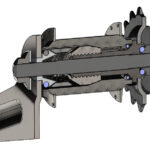The story of Big Dirt Bikes takes us back to the 1980s, a time when three-wheeled ATVs were capturing the adventurous spirit of riders. Yamaha stepped into this scene with the 1985 BW-200N, a machine that sported those distinctive big wheels right from the factory. This arrival coincided with the peak popularity of 3-wheeled ATVs, before safety regulations shifted the industry’s direction.
Following the USCPSC ATV Consent Decree, which came about due to safety concerns and numerous lawsuits, the era of 3-wheeled ATVs came to an abrupt end. Manufacturers decided to discontinue them, and the Yamaha BW series, initially linked to this trend, also faced an uncertain future. While 4-wheeled ATVs became the new standard, adorned with numerous warning labels, the spirit of those big-wheeled machines lived on in different forms.
Honda also briefly ventured into this niche with the TR-200 Fat Cat. Produced in 1986 and 1987, the Fat Cat featured an automatic clutch and borrowed its engine from the 1986 TRX-200SX ATV. The “Fat Cat” moniker proved catchy, sometimes even used by Yamaha BW owners, blurring the lines between models in casual conversation.
Yamaha’s BW series was diverse, offering 80cc, 200cc, and 350cc models. Having owned each at some point, personal experience offers valuable insight into these bikes. The 1986 BW-80S was a playful machine, perfect for casual riding around the yard or less demanding terrains where high speed wasn’t a priority. Its torquey engine, derived from the PW-80 and tracing back to older Yamaha 2-stroke designs, combined with a 3-speed transmission and automatic clutch, made it a reliable and user-friendly option. It remained in production for several years, appealing to riders from 1986 to 1990.
The BW-200 marked the beginning of the BW line. It was available in both kick-start and electric-start/kick-start versions. Its engine, originating from the 1981 SR-185H Exciter street bike, became a staple in various Yamaha models, including today’s TT-R230, showcasing its enduring design. Produced from 1985 to 1988, the BW-200 gained considerable attention in ATV magazines of the time. However, in practical riding experience, it felt somewhat underpowered for its weight in its stock form. While aftermarket modifications could potentially enhance its performance, keeping it stock, with the exception of upgraded Works Performance twin shocks, led to a relatively short ownership period due to underwhelming power.
In contrast to the BW-200, the 1987 BW-350T (also available in 1988 as the BW-350U) offered a more engaging riding experience. Its engine, while not directly from the XT-350, was a unique blend. It incorporated a single cam, 2-valve top end from the 1987 Warrior 350 ATV (a lineage that continues with the Raptor 350 ATV) and a bottom end constructed from 1980 XT-250, SR-250, and BW-350 specific components. This engine architecture had roots in the classic 1976 TT-500C and XT-500C models. Although heavier than the BW-200, the BW-350 delivered a noticeable increase in power and torque, making it a more satisfying ride for those seeking more performance from their big wheel dirt bike.
These big wheel dirt bikes from Yamaha and Honda represent a unique chapter in off-road vehicle history. They bridged a gap between motorcycles and ATVs, offering a distinctive riding experience that resonated with enthusiasts in the 80s and continues to fascinate vintage bike collectors and fans today.

